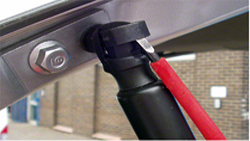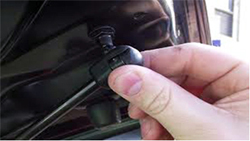Application
In their technical design, gas springs must be customized for special applications-on the basis of specifications and drawings. Match your application and requirements with us. Our consultants will be glad to help you.
Mounting Instructions & Orientation
If possible, install gas springs so that the piston rod points down in the inactive state – unless they were designed for non-orientation specific installation. This will ensure optimum lubrication of the guide and sealing system at all times.
• Mount the gas spring with piston rod facing downwards for better damping.
• Tight all mounting nuts / screws properly.
• Allow free movement in hole, in case of clevis (Eyelet Type) end connection.
• Prevent side loads on gas springs this can cause bending of piston rod or early wear.
• The tube must be protected from dents, & should not be deformed. As such damage could destroy the sealing systems.
• If gas springs are fitted in applications where failure means risk of health or life, we recommend using additional locking mechanisms.This is customer responsibility.
• Unless specifically designed for tension loads, gas spring must not be loaded with traction forces.
• Do not extend or retract gas springs beyond their design specifications.
• Ideal expect end users to test gas springs, because it is not possilble to simulate or anticipate the complate range of situations where our products may be used.
• High accelerations or velocities during extension or compression must not overload unit.
• To prevent damage to the gas spring and to maximize its life span, please allow 10% margin to the standard stroke to reduce shock that is caused by the compression of gas. The margin can prevent damage on the gas spring when the piston rod touches the bottom surface and shortening a lifespan due to the impact by maximum gas pressure
• Do the fitment of gas spring preferably from skilled mechanic.
• operating temp. Range : (-20° C to + 80° C)
• Gas Springs are maintenance free. Do not grease or oil the gas spring.
• Piston rod must not be painted & should be protected against scratches, dirt & dent. As such damage could destroy the sealing systems
• Gas Springs are not to be fitted in any application other than specified
• Unless specifically designed for tension loads, gas spring must not be loaded with traction froces

Insert screw driver tip in the clip as shown and pull the gas spring

Push the socket on ball pin to mount the gas spring
No Jamming
For a long service life, gas springs must not jam or be subjected to bending or lateral forces. We offer suitable end fittings, such as angle joints. They will ensure non-jamming alignment.
Functional Safety
The functional safety of a gas spring comes mainly from the smooth piston rod surface and the seals that keep the gas pressure on the inside. Do not subject gas springs to bending stresses. You should not install gas springs that have been damaged in after-sales, mechanical processing. Welding on the gas spring, as well as contamination or paint on the piston rod can cause device failure. Avoid modifications and manipulations, impacts, tensile stress, heating, painting, and removal of the imprint. Be on the safe side: Do not install defective or improperly altered products.
Temperature Range
IDEAL gas springs are designed for a default temperature range of -20°C to +80°C. Of course, there are also gas springs for more extreme applications.
Life and Maintenance
Gas springs are maintenance-free! They do not require greasing or lubrication. They are designed for their corresponding applications and will work flawlessly for many years.
Transportation and Storage
Store gas springs with the piston rod pointing down. Actuate the gas spring after 6 months of storage. Avoid damage: Do not transport gas springs as bulk material. Make sure not to contaminate gas springs with thin packaging film or adhesive tape.
Caution
Do not heat / open or put in openfire the gas spring, such act may lead to injuries because of high pressure.We are not responsible for any damages or any kind.
Disposal
Gas spring consists mostly the metal which can be recycled, but firstly it should be depressurized. Please ask us about the disposal instructions. When gas springs are no longer needed, they should be disposed of in an environmentally correct manner. For this purpose they should be drilled, release the compressed nitrogen gas and the oil to be drained. For more specific details, please refer to our disposal instructions.
Warning
With gas spring fully charged with high pressure gas, non-compliance with this warning may lead to accidents , product damages , malfunctions , etc. Before using the spring make sure to fully understand and observe the warning below

 Insert screw driver tip in the clip as shown and pull the gas spring
Insert screw driver tip in the clip as shown and pull the gas spring Push the socket on ball pin to mount the gas spring
Push the socket on ball pin to mount the gas spring

